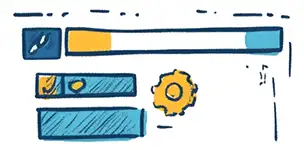Optimising your website's SEO is essential for driving traffic and improving site performance.
At Webstudio, we focus on a continuous process of on-site SEO optimisation to ensure your web pages are effectively targeting the right audience.
This article explains how we use search terms and SEO best practices to optimise your web pages, helping you achieve better search engine rankings and reach the right visitors.

Search Term Identification
Before any optimisation begins, we start with search term identification. Using a variety of tools, including Google Ads Keyword Planner, Ahrefs, and our own keyword suggestion tool, we identify the most relevant search terms for your business.
These terms are chosen based on their potential to attract the right kind of visitors—those who are likely to be interested in your products or services.

Creating and Optimising Content - the 5 main areas of on-site optimisation
Once we have identified the appropriate search terms, we create the content, whether it's a blog post, article, or another type of page. The optimisation process includes several key steps:
- Title Optimisation: The title is what appears in the browser tab and the search engine listing. It’s important that this is not only relevant to the search terms but also enticing enough to encourage clicks. It should clearly reflect the content of the page and include the primary search term.
- Heading Optimisation: The heading is what your visitors see at the top of the page. It needs to be clear, useful, and directly related to the user’s search query. A well-crafted heading helps in grabbing the reader's attention and sets the tone for the content that follows. The headings are heirarchical, <h1>, <h2>, <h3> etc so we use these in order down the page for each of the sections.
- URL Structure: The URL should be clean, easy to read, and include the main search term. A well-structured URL can enhance both user experience and search engine understanding of the page's content.
- Content Quality: The content itself is crucial. It must be unique, relevant, and engaging, written in a way that speaks directly to your target audience. We ensure that the content is well-structured, informative, and addresses the search intent of your visitors.
- Image Optimisation: Images used on the page should be relevant to the content and optimised with appropriate names, alt text, and titles that include the target search terms. This helps search engines understand the content of your images and can improve your page’s visibility in search results. Do not keyword stuff your alt tag, this is designed for accessibility and it shoudl describe what the image is. Use the title tag instead for the keyword and this will appear as a tooltip when someone hovers on it.

Internal Linking and Pillar Pages
We also focus on internal linking, which involves linking the new content to other relevant pages on your site.
This helps search engines crawl your site more effectively and boosts the authority of the linked pages.
We often group related content into clusters that support a pillar page - a central, comprehensive page on a key topic.
This technique, known as a pillar-cluster model, enhances your website’s topical authority and helps search engines recognise the depth and breadth of your content on a particular subject.

Continuous Optimisation
Our approach to SEO is not a one-time task but a continuous process.
Initially, we optimise your page based on the search terms we want to target.
However, as time goes by, we use our system to track how the page performs, particularly which search terms are bringing traffic.
We then revisit the page to re-optimise it, focusing on the terms that are actually driving traffic, especially if they align with the type of search intent we are targeting.
This process is crucial, especially when the initially targeted search terms are highly competitive.
By continuously refining the page, we ensure it attracts the right audience and improves its ranking over time.

Summary Of Our On-site Optimisation
On-site SEO optimisation is an ongoing process that involves carefully selecting search terms, creating high-quality content, and continuously refining your pages based on performance data.
By following these best practices, we help your website attract the right visitors and improve its search engine rankings, ultimately driving more business to your site.
Whether you’re targeting competitive search terms or looking to enhance your existing pages, our SEO strategies are designed to deliver long-term success.

- What is on-site SEO optimisation, and why is it important?
On-site SEO optimisation involves refining elements within your website, such as content, titles, URLs, and images, to improve its performance in search engine rankings. It helps attract the right audience and ensures your site is visible to those searching for your products or services. - How do you choose the right search terms for my website?
We use advanced tools like Google Ads Keyword Planner, Ahrefs, and our own keyword suggestion tools to identify search terms that align with your business goals and attract high-intent visitors. These terms are chosen based on their relevance and potential to drive quality traffic. - What is the pillar-cluster model, and how does it benefit my website?
The pillar-cluster model groups related content into clusters around a central pillar page. This structure improves your website’s topical authority, helps search engines understand your site’s focus, and boosts rankings for key topics. - How often should pages be re-optimised?
SEO is an ongoing process. We monitor the performance of your pages over time, focusing on search terms that drive traffic. Regular re-optimisation ensures your pages stay competitive, adapt to changes in search behaviour, and continue to attract the right audience. - How does image optimisation help with SEO?
Properly optimising images with relevant file names, alt text, and titles improves your page’s visibility in search results. It also enhances user experience by making your content more accessible and visually appealing, which can positively impact rankings.

Author
Technical Director
With over 20 years of experience in building and promoting websites, Neil is a seasoned expert in digital marketing and SEO. Passionate about helping businesses grow through innovative web solutions, Neil has successfully built over 400 websites.

